Welcome to my collection of Pre-K classroom photos! This page features photos of my very first classroom in the Washington, D.C., metro area, wayyy back in 1999! I didn’t have access to a digital camera until 2003, so the classroom tours on this site unfortunately don’t start until that year. However, I recently found a notebook with PreK classroom pictures that I apparently took (and wrote descriptions for!) back when I had only been teaching a few months. This was an especially precious find to me because they’re the only pictures I have from my preschool/HeadStart teaching years (1999-2002.) I’ve scanned and uploaded the photos here and typed the descriptions exactly as they’re written in the notebook so that it feels like you’ve just walked into my room and are taking a tour.
Note: Since these photos are so old, I’ve chosen not to blur the faces of the students. The “kids” are now all grown adults (I can’t believe it!), and since I’m not revealing which school the photos were taken at, I don’t think there’s any threat to their anonymity. They kids are so precious that I didn’t want to ruin the pictures by taking them out. If you happen to recognize yourself or someone you know and would like the photo to be edited, just shoot me an email and I’ll fix it.
Classroom pictures
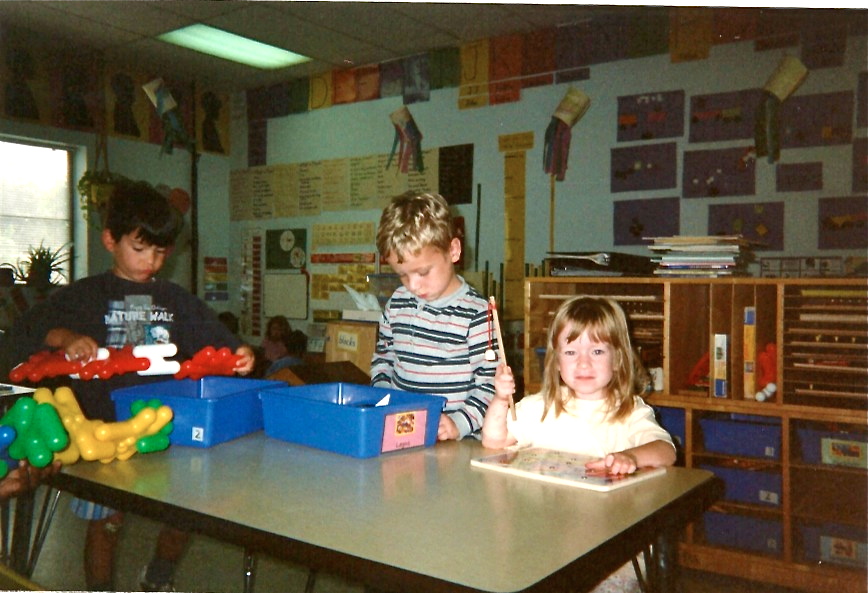
When at school, the majority of our day is devoted to hands-on learning experiences in centers. [Note: During my first year of teaching, children were allowed to select their center choices freely, changing at any time as long as they had cleaned up their area first. Later as the school district began creating mandates for pre-kindergarten classrooms, the children had to select a specific center and stay there for a certain amount of time. I also required that they visit certain centers at certain times.]
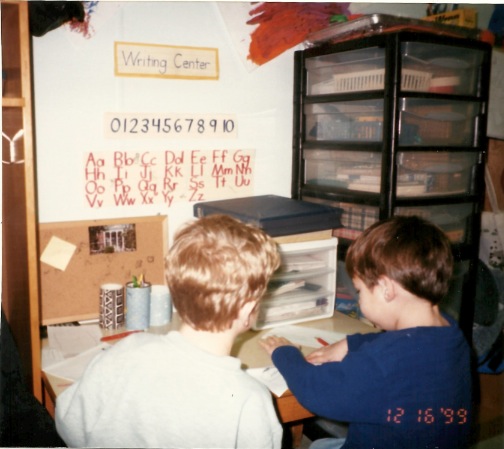
The writing center is one of the most popular centers in the classroom: it allows the children to use writing, drawing, typing, and alphabet stamping for a purpose. Pencils, pens, and markers are provided along with dozens of writing materials: postcards, envelopes, carbon paper, notepads, sticky notes, and so on. I also add in more unusual materials as I find them: phone books, address books, toy catalogs, chidlren’s magazines, a bulletin board, a pretend mailbox, notebooks, and more. The proper form for letters and numbers is dispalyed above the table for reference.
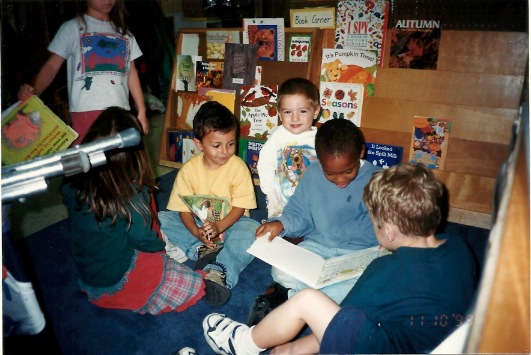
In the book corner, we have two shelves full of library books that are related to our current unit of study. There is also a listening center featruring a variety of books on tape for the children to listen to.
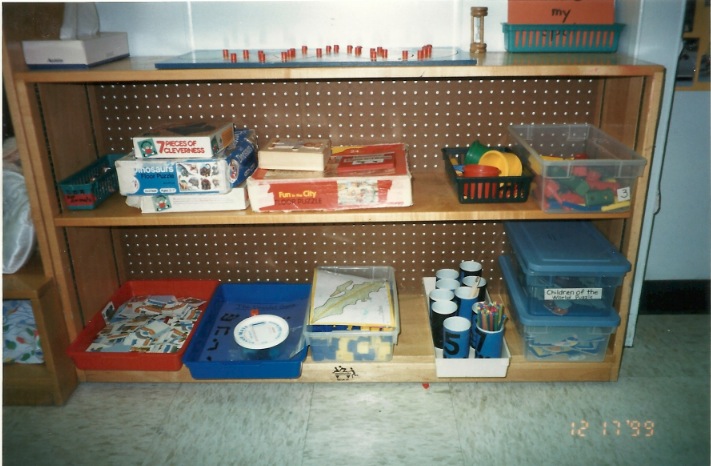
The science and math shelf containes a variety of age-appropriate materials that strengthen reasoning skills, hand-eye coordination, and mathematical concepts such as one-to-one correspondence.
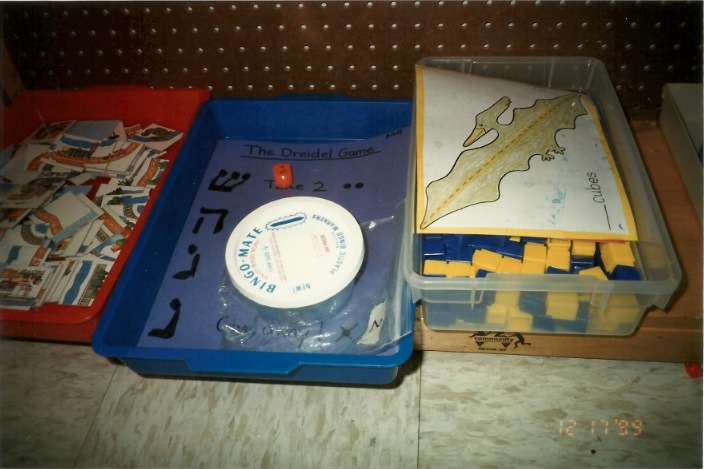
Many games on the shelf are teacher-made. This photograph shows the Dreidel game, a simplified version of the original in which children spin the Dreidel and collect or give away pieces according to what is spun, and a measuring activity, in which children use multi-links to measure the length of dinosaurs and write the numeral using wipe-off pens.
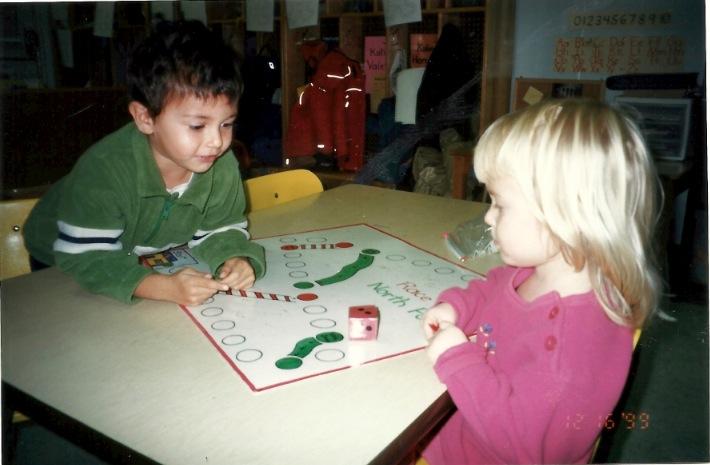
Teacher-made games: two player practice. These games (of which I create 2-4 per theme) are designed to be as much fun as commerically-made children’s games but involve the important concepts of one-to-one corespndence and counting that many of the other games do not. In this simple game, the children roll the die (which goes up to three and features dots which can counted rather than numerals which must be recognized) and move around the game board. Slides and ladders have been added for interest. In a more complex game (not pictured), the children roll a 1-6 die and move accordingly, picking up the appropriate number of fun-shaped erasers that correspond to the pictures landed on. At the game’s end, the children analyze who has the most snowpeople, trees, stockings, and candy cane erasers.
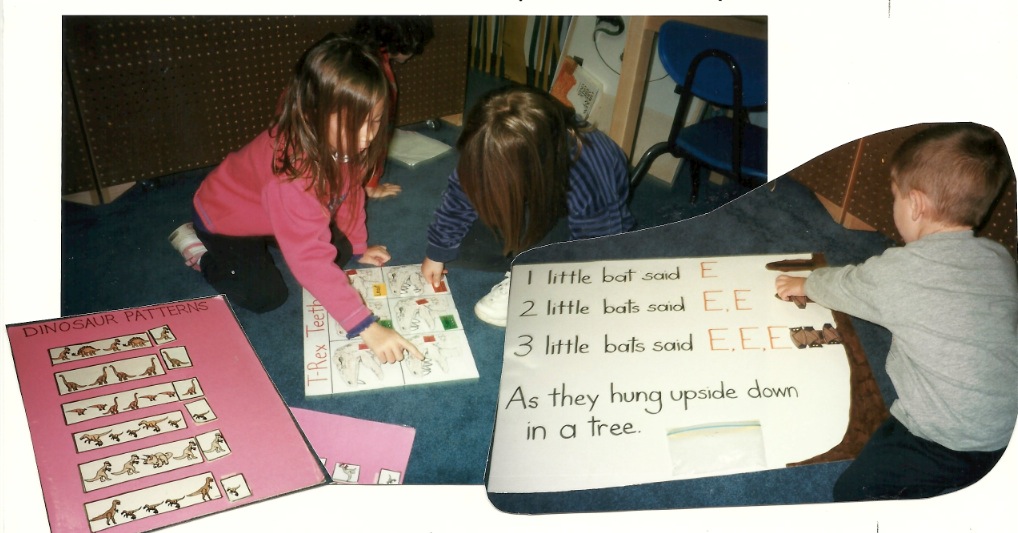
Teacher-made games: One person skills reinforcement. For each unit, I also construct 2-4 developmentally appropriate one person games as supplements, and they often prove to be the most popular materials in the classroom because they are tailored to the class’ interests. The pink game above gives practice in patterning; the one in the middle develops the skils of one-to-one correspondence and number recognition as the children place the correct number of teeth on each T-Rex. There are also pieces that say most, least, and same as so that the children can analyze their work. To the right is a chart for Halloween that provides practice for one-to-one correspondence: children say/read the rhyme and place magnetized bats on the tree
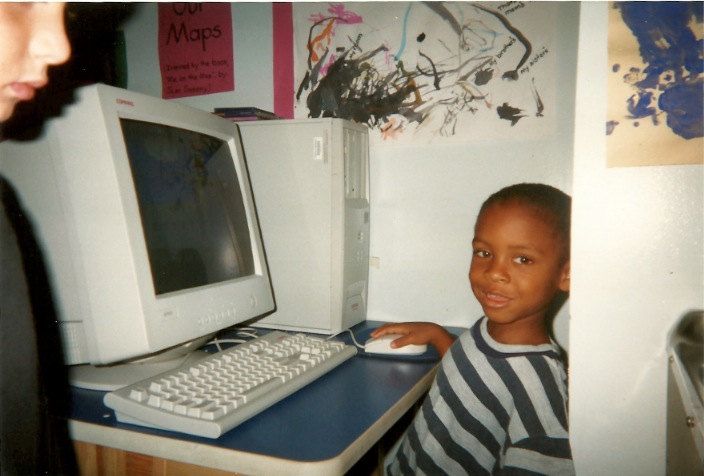
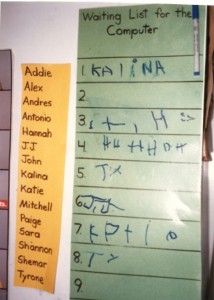
The computer is an integral part of our classroom. I rotate a variety of developmentally appropriate software for the children to explore during center time. All of our games provide practice in importatnt skills such as shape/color recognition, patterning, rhyming, and counting, and allow for a great variance in ability. [No internet capability in any of the classrooms. And I don’t think the term “differentiating” had been coined yet!”]
The computer waiting list serves not only to ensure students that they will get a turn, but provides a purpose for writing one’s name:many of the children show no interest in writing their names on their artwork, but will work diligentl on doing so for the cmputer wiaitng list, even when there is no wait!
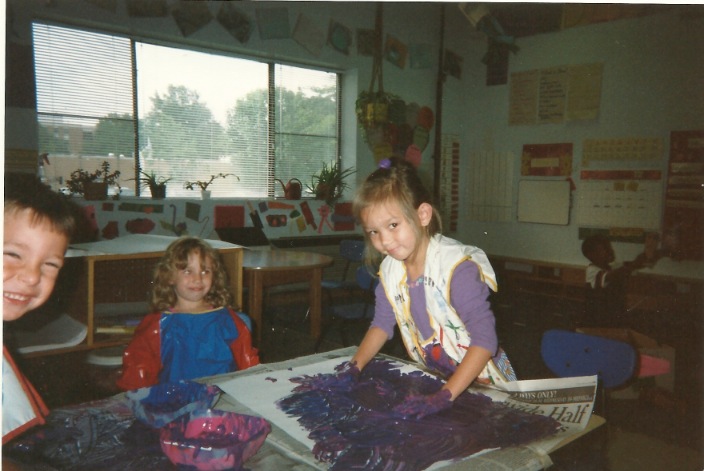
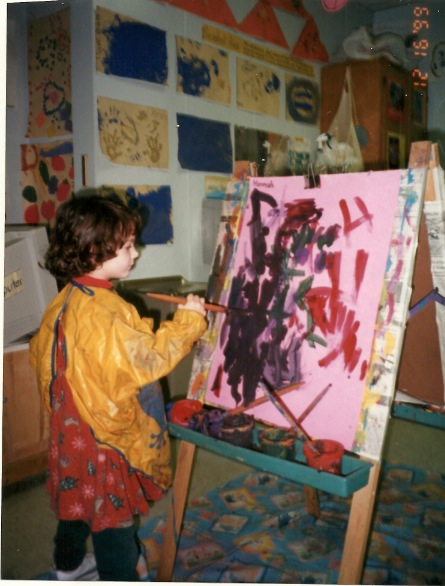
The easel and finger painting are a part of our regular center routine, providing essential sensory experiences for the children.

In addition to the open-ended matierals that are provided for art each day (a variety of paint and paper in various colors and shapes), we do many projects that are related to what we are studying. This is a project we did during our dinosaur theme, on Stegosaurus day: each child was given a cut-out Stegosaurus with no plates. The children painted the dinosaurs and glued on sandpaper plates in any fashion they wanted. I then glued the dinosaurs onto butcher paper, named them after the children who created them, and analyzed them with the class. We counted the plates on each dinosaur, and I wrote the appropriate number on the dinosaurs’ back. Each child then wrote that number on his or her own dinosaur’s back, modeling it after mine. We discussed the plates on our creations in terms of most, least, and same as.
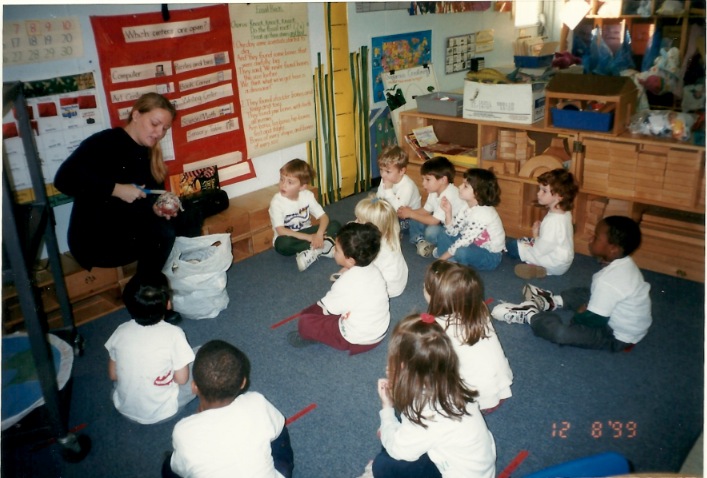
The area where we have circle is full of materials that we use for reference during instructional periods. In addition to the charts for calendar, cetners, and meteoroligst charts, we have a chart for our jobs which rotate weekly. We also dislay our birthdays and color words, along with materials specific to the unit we are studying. Recently, we have had the lyrics to songs we know (which we often anaylze, circling specific letters we are looking for), graphs we constructed, and articles of interst from magazines and newspapers.
The double-functioning center chart aids the children in word recogniion and is also a concrete reminder of which centers are open. Whenever we come into the classroom from another room or from outside, we immediately come to the carpet for any special instructions and to decide which cetners are open. The chart remians on the wall as a refernce for any children who come in late or forget what their options are.

The calendar is more than just a way to track time in our class: it is a way to mark important dates and to make the concept of future events more meaningful and concrete. We put all holidays and birthdays on our calendar, as well as special events at school and things that are personally significant to the children, ie. “John’s dad comes back from Texas today” and “Addie’s dentist appointment.” This shows children the practical uses of a calendar. Additionally, we count up to the correct day each morning at circle, with the children taking turns finding the correct number from a chart.A number line is above the calendar to help the children identify the numbers.
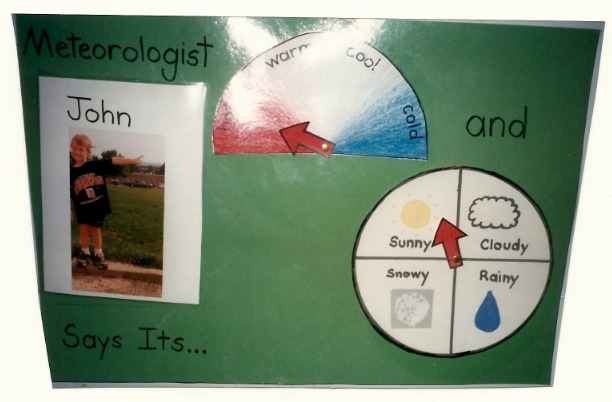
The children have photographs of themselves pointing to the Meteorologist Chart and take turns putting photos up and telling us the weather. We read their analysis in sentence form, with a child pointing to each word as it is read: “Meteorologist John says it is cold and sunny.” Gradiation in temperature is allowed for, providing additional vocabulary words and making weather analysis more specific. Even the youngest preschoolers are able to pronounce the word “meteorologist” and understand what the terms means as a result of this daily routine.
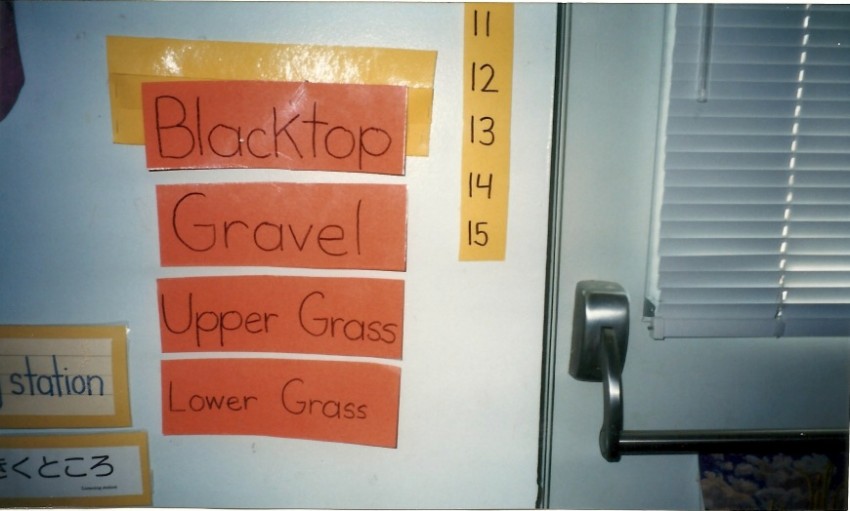
The “Outside Time” organizer serves as both a behavior management technique and practice in letter and number recognition. This is an area we look to each day before going outside. The chldren line up, each choosing a number from 1-15 written on the floor. I choose the orange sign that shows the area we have been assigned to for that day and the children “read” it by looking at the initial letter and praacticing that sound. I then choose a number, pointing to it on the number line on the wall, and the child standing on that number gets to be line leader. Ths routines focuses the children while they are waiting in line, and they know that only “quiet numbers” that no one fights over are picked!
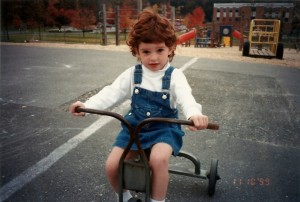
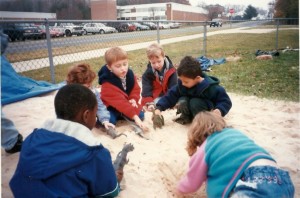
Time outside is integral to our curriculum. To the left: the children work together to dig for “fossils” we made out of salt dough. To the right: bike riding is always popular.
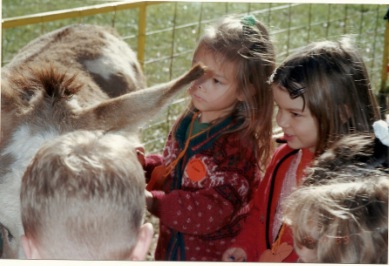
We take field trips into the community quite frequently: this is a picture of our visit to a farm.
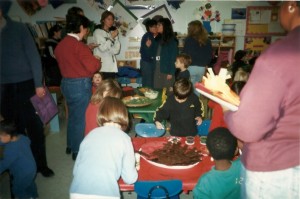
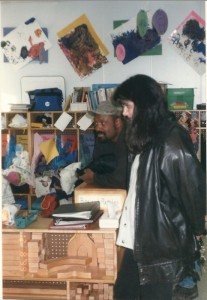
Parents are always welcome in our classroom. The left picture shows parents who stopped by to watch a special lesson; the right shows our holiday party. The kids and parents decorated gingerbread cookies together. We gave handprint paintings as gifts, and the children made Gluep as presents for one another.
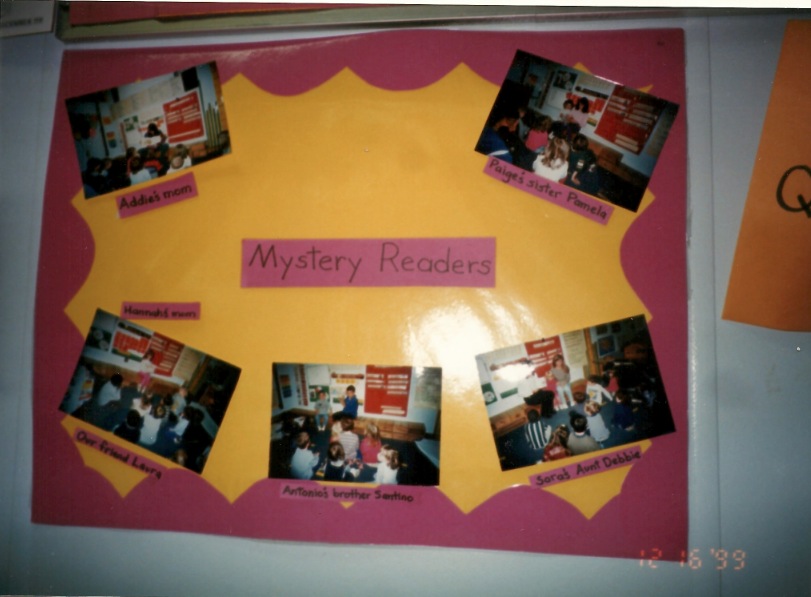
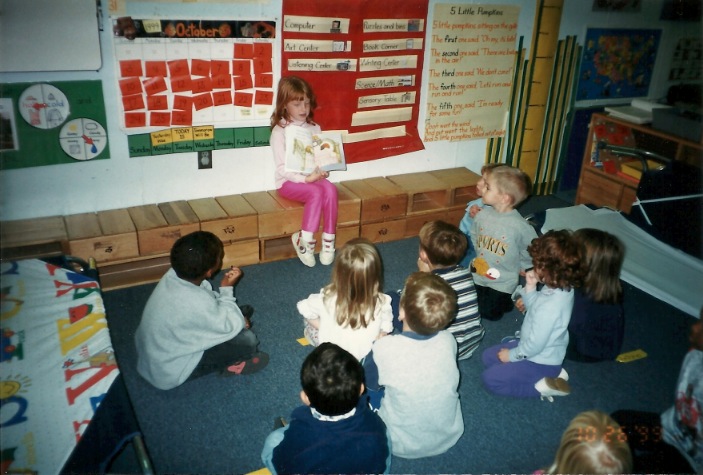
Our Mystery Readers program is very popular. Once a week, a surprise visitor comes to share a story with the class. This really gets the children excited about literature and about learning to read. Pictured are our Mystery Rader bulletin board with pictures of all our visitors, and a kindergartner who has come back to our classroom to read to us.
More of My Classroom Tours

Classroom Photos After 2009
Classroom Photos 2009
Classroom Photos 2008
Classroom Photos 2007
Classroom Photos 2006
Classroom Photos 2005
Classroom Photos 2004
Classroom Photos 2003
Check Out Other Teachers’ Classroom Photos
Want to see photos of Other Teachers’ Rooms? I’ve collected classroom pictures from educators in all different parts of the United States! Learn their tips for desk arrangement, organization, and more.
Please Share YOUR Classroom Photos!
Would you like to have your pictures featured here? I’d love to add your classroom pics to the Other Teachers’ Rooms page! Contact me via email with the link to your Flickr, Tumblr, Picassa, blog, Pinterest board, or even a public Facebook album! Don’t worry about making sure everything looks perfect: we want to see REAL classrooms that are used by REAL students every day! International teachers–we’d especially love to see what your rooms look like!

Angela Watson
Founder and Writer
Sign up to get new Truth for Teachers articles in your inbox
OR

Join our
community
of educators
If you are a teacher who is interested in contributing to the Truth for Teachers website, please click here for more information.















